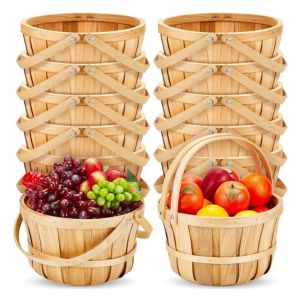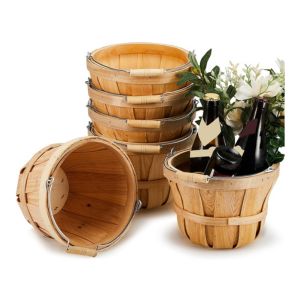A bushel of apples is a common unit of measurement in agriculture, especially when purchasing apples in bulk for cooking, baking, canning, or simply enjoying fresh. But when you hear the term “bushel,” how much does it really mean in terms of weight?
Understanding the weight of a bushel of apples is not only important for those who buy apples in bulk, but also for farmers, orchardists, and anyone involved in agricultural trade. Whether you’re making homemade apple cider, canning applesauce, or preparing pies for a family gathering, knowing the weight of a bushel of apples is essential.
In this article, we will explore what a bushel of apples is, how the weight can vary depending on several factors, and why this information is important when buying, cooking, or storing apples. We’ll also provide insights into how much a bushel costs, its dimensions, and its uses. Plus, you’ll discover some fun facts about apples that will help you appreciate this delicious and nutritious fruit even more.
What Is a Bushel of Apples?
A bushel is a traditional unit of dry volume used in agriculture, most commonly for measuring fruits, vegetables, and grains. For apples, a bushel is legally defined as 2,150.42 cubic inches, which equals approximately 9 U.S. dry gallons. This volume measurement is standard across the United States and is used when buying and selling apples in bulk, especially in orchards or at farmer’s markets.
In terms of apples, a bushel is typically filled with about 125 to 150 medium-sized apples, but this can vary depending on the size and variety of apples. This large volume makes the bushel a popular option for consumers who need to purchase large quantities of apples for various purposes like baking, canning, or making cider.
Key Points to Remember About a Bushel of Apples:
- A bushel is a unit of volume, not weight.
- It contains approximately 125 to 150 medium-sized apples.
- The weight of a bushel of apples typically ranges from 40 to 48 pounds or 18 to 36 kg depending on factors like size and moisture content.
How Much Does a Bushel of Apples Weigh?
The weight of a bushel of apples is not fixed and can vary based on several factors. However, the general weight range for a bushel of apples is 40 to 48 pounds or 18 to 36 kg. The exact weight depends on the apple variety, the moisture content of the apples, how tightly the apples are packed into the bushel, and even the specific growing conditions of the apples.
Factors Influencing the Weight of a Bushel of Apples:
- Apple Variety:
- Different varieties of apples have different sizes and densities. Larger varieties like Honeycrisp, Fuji, or Gala apples tend to weigh more than smaller varieties like Granny Smith or Crabapples. A bushel of Fuji apples, for example, can weigh up to 48 pounds, while a bushel of Gala apples might be closer to 40 pounds.
- Moisture Content:
- Apples that have higher moisture content will weigh more. Apples grown in wetter climates or harvested during rainy seasons tend to have more water, increasing their overall weight. Apples harvested at peak ripeness also tend to have higher water content, which contributes to the weight.
- Packing Method:
- A bushel of apples can be packed tightly or loosely. Tightly packed apples will make the bushel heavier, while loosely packed apples will result in a lighter bushel. This is why some farm markets or grocery stores may offer bushels with varying weight based on how the apples are packed.
- Size and Shape of Apples:
- Larger apples with a firmer texture (like Honeycrisp and Fuji) will fill a bushel with fewer apples, but the bushel will weigh more. Smaller apples (like Gala) fill the bushel with more apples, but the overall weight of the bushel may be lighter.
- Ripeness and Harvest Time:
- Apples harvested later in the growing season, when they’re fully ripe, tend to have more sugar and water, which makes them heavier. Apples picked earlier, or those that are past their prime, may weigh less.
| Preview | Name | Price |
 | Marsui 10 Pcs Large Wooden Bushel Baskets | VIEW ON AMAZON |
 | 6 Pack Round Wooden Fruit Baskets Small Bushel Apple Buckets | VIEW ON AMAZON |
 | Tatuo 4 Pcs Round Wooden Apple Baskets | VIEW ON AMAZON |
Comparison Table: Weight, Price, and Other Factors of a Bushel of Apples
To give you a better understanding of how different apple varieties affect the weight and pricing of a bushel, here’s a comparison table that highlights various apple types and their attributes.
| Apple Variety | Approx. Weight per Bushel (lbs) | Price per Bushel (USD) | Uses | Notes |
|---|---|---|---|---|
| Gala | 40 | $30 | Snacking, salads, baking | Sweet, crisp texture |
| Honeycrisp | 45 | $35 | Baking, cider making, snacking | Juicy, balanced sweet-tart flavor |
| Granny Smith | 42 | $28 | Pies, baking, cooking | Tart, firm texture ideal for baking |
| Fuji | 48 | $40 | Snacking, salads, baking | Sweet, crunchy, great for fresh eating |
| Red Delicious | 44 | $32 | Snacking, salads | Mildly sweet, soft texture |
Note: Prices are approximate and can vary depending on the region, season, and market conditions.
Basics of a Bushel of Apples Weight
The curb weight of a bushel refers to the weight of the apples inside the bushel itself, excluding packaging materials like baskets or crates. The weight of a bushel is typically between 40 to 48 pounds, and this weight is standardized across markets to help buyers and sellers know exactly how much they’re getting.
- A bushel of apples usually contains about 125 to 150 medium-sized apples, depending on the size and variety.
- When purchasing apples in bulk, it’s helpful to know that 1 bushel = approximately 9 dry gallons or 2,150.42 cubic inches.
The standardization of a bushel’s weight ensures consistency for buyers and helps calculate the exact quantity of apples for canning, baking, or any other purpose. As apples come in many varieties, the density and size of each can have a major impact on how much a bushel weighs.
Factors Influencing a Bushel of Apples Weight
1. Apple Variety
Different apple varieties have varying sizes and densities, meaning that a bushel of Honeycrisp apples will likely weigh more than a bushel of Gala apples. Apples like Fuji and Granny Smith have more solid and dense flesh, while apples like Crabapples are smaller and less dense.
- Smaller apples like Gala or Crabapples tend to fill a bushel with more apples, but the overall weight will be less.
- Larger apples like Fuji or Honeycrisp will result in fewer apples per bushel, but each apple is denser, adding more weight.
2. Moisture Content
Water content is a major factor in determining the weight of apples. Apples harvested during wetter seasons or those with higher water retention will have more moisture and, therefore, weigh more. For instance, a Honeycrisp apple grown in a wet climate may weigh more than the same variety grown in a drier region.
3. Packing Method
The method used to pack the apples into a bushel can affect its weight. Apples that are packed tightly will result in a heavier bushel, whereas loosely packed apples can create a lighter bushel. The packing method ensures that each bushel is appropriately filled to its legal volume, though the tightness of the packing is up to the supplier.
4. Size and Shape of Apples
Larger apples, such as Honeycrisp or Fuji, are bulkier and denser, meaning they will fill the bushel with fewer apples but the overall weight of the bushel will be higher. Conversely, smaller apples like Crabapples or Gala apples, though numerous, are less dense, meaning they result in a lighter bushel.
5. Ripeness and Harvest Time
Apples harvested at their peak of ripeness generally have more water and sugar content, making them heavier. Apples picked too early or after they have over-ripened will have lower water content and therefore weigh less.
Why a Bushel of Apples Weight Matters
Understanding the weight of a bushel of apples is essential for several reasons:
- Recipe Accuracy: Many recipes, especially for baking or canning, require a specific weight of apples. Whether you’re making applesauce, pies, or cider, knowing the weight of a bushel ensures that you’re purchasing the right amount.
- Canning and Preserving: If you’re planning to can apples for preserves or applesauce, knowing the weight helps estimate how many jars or containers you’ll need. Typically, one bushel yields 15-18 quarts of applesauce.
- Cost and Purchase Decisions: For consumers purchasing in bulk, knowing the weight and price of a bushel can help determine the best value for their money.
- Storage and Transport: For those purchasing large quantities of apples, understanding the weight ensures that storage space and transportation logistics are properly planned.
How Much Does a Bushel of Apples Cost?
The price of a bushel of apples varies based on the type of apples, market conditions, location, and whether the apples are organic or conventionally grown. On average, the price of a bushel of apples can range from $28 to $40.
- Gala and Red Delicious apples are usually more affordable, ranging from $28 to $32 per bushel.
- Premium apples like Honeycrisp or Fuji can cost anywhere from $35 to $40 per bushel.
Prices can fluctuate depending on the region, market demand, and the time of year. Apples that are in-season are generally cheaper than those that are off-season or require longer transportation times.
What Is the Size/Dimension of a Bushel of Apples?
A standard bushel for apples is a unit of volume, measuring 2,150.42 cubic inches (9 U.S. dry gallons). This is equivalent to about 1.8 cubic feet. The basket used to hold a bushel is usually about 12 inches in height and 18 inches in diameter, though this can vary slightly depending on the supplier. A bushel can comfortably fit 125 to 150 medium-sized apples depending on the apple type.
How Big Is a Bushel of Apples?
A bushel of apples typically contains 125 to 150 medium-sized apples. However, the number can vary depending on the size and density of the apples. For example, larger apples such as Honeycrisp will fill the bushel with fewer apples, while smaller apples like Gala or Granny Smith will fill the bushel with more apples.
Uses of a Bushel of Apples
A bushel of apples can be used in many ways:
- Canning and Preserving: A bushel yields enough apples for 15 to 18 quarts of applesauce or about 20 to 25 jars of apple preserves.
- Baking: A bushel of apples can provide enough apples for 8 to 10 pies, depending on the variety and size of the apples.
- Juicing and Cider Making: If you’re making fresh apple cider, a bushel is enough to make several gallons of juice.
- Fresh Eating: For families or larger households, a bushel provides a steady supply of apples for snacking, salads, or cooking.
Conclusion
A bushel of apples is an excellent way to purchase apples in bulk, especially if you’re planning to bake, can, or enjoy fresh apples for an extended period. Knowing the weight and size of a bushel helps you determine how much you’re actually buying and ensures that you purchase the right amount for your needs. Whether you’re using a bushel for homemade apple pies or applesauce, understanding the weight, price, and uses of a bushel of apples will make your culinary or agricultural tasks more efficient and enjoyable.
Fun Facts
- Apple Varieties: There are over 7,500 types of apples grown worldwide, each with its unique flavor, texture, and use.
- Apple Consumption: The average American consumes approximately 65 pounds of apples annually.
- Cider Making: It takes about 36 apples to produce 1 gallon of apple cider.
- Apple Trees: An apple tree can produce up to 2,000 apples in a season, depending on the variety and growing conditions.
